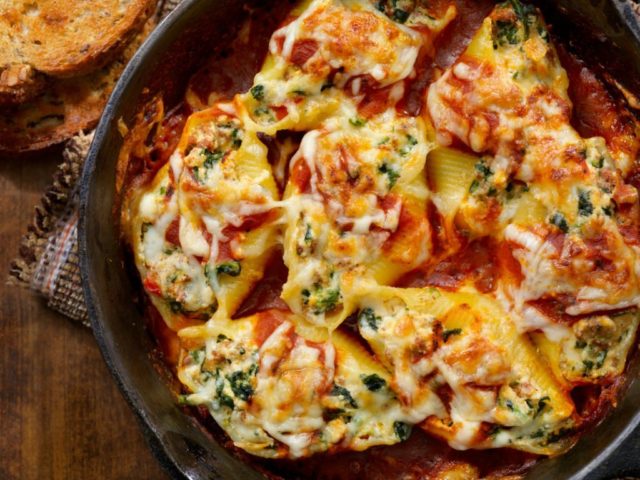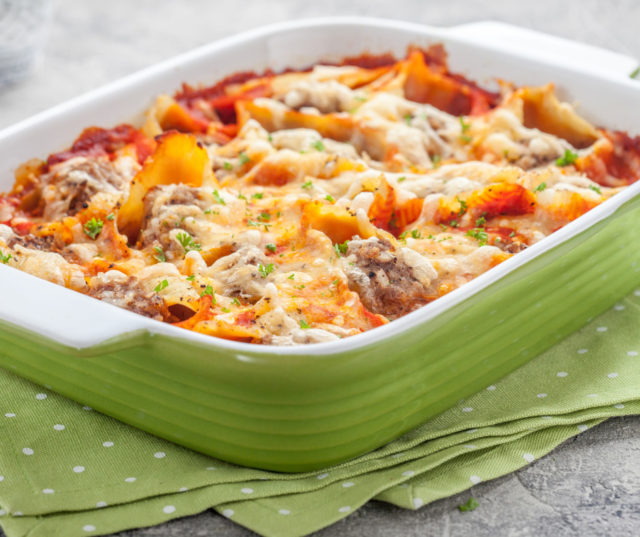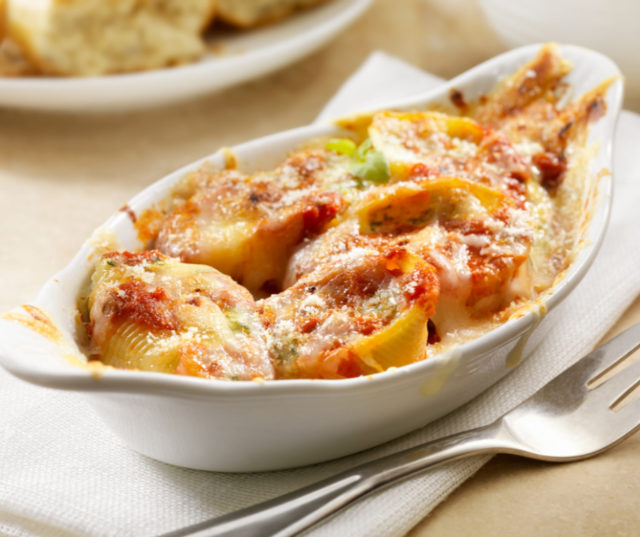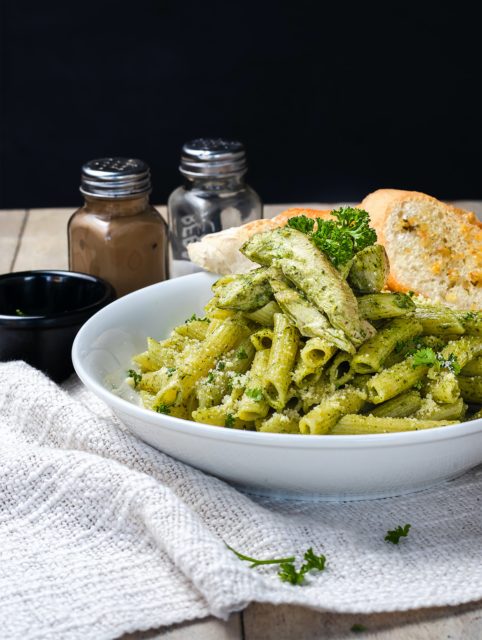In the States, we’re already used to eating baked pasta with our beloved mac and cheese. But have you ever thought of trying something different? Baked pasta is a perfect alternative that blends layers of pasta with a delicious creamy sauce and the crispiness of grilled cheese.
Whether it’s your favorite spaghetti and meatballs baked with gooey mozzarella cheese or baked ziti stuffed with ricotta and ground beef, you’ll find that baked pasta is a delicious way to pamper yourself. And unlike traditional stovetop pasta dishes, baked pasta is incredibly easy to make – all you need is a baking dish, your favorite baked pasta recipe, and a few simple ingredients.
What is baked pasta?
Baked pasta, or pasta al forno, has a really long history. As early as the Middle Ages and Renaissance, oven baked ziti, a kind of tubular pasta, were served on Italian tables at the banquets.
Throughout Sicily and Campania, baked pasta remains a favorite amongst many on Sundays or during special get-togethers. Today, baked pasta remains incredibly popular, from authentic recipes passed down from generation to generation to new and exciting variations that will delight the senses.
1. You can enjoy baked pasta in different ways
There are many different baked pasta dishes out there, each with their own unique flavors and textures. Some of the most popular baked pasta varieties include baked lasagna, baked mac and cheese, baked ravioli, baked penne pasta, baked bow tie pasta, baked gnocchi, baked tortellini, baked ziti and much more.
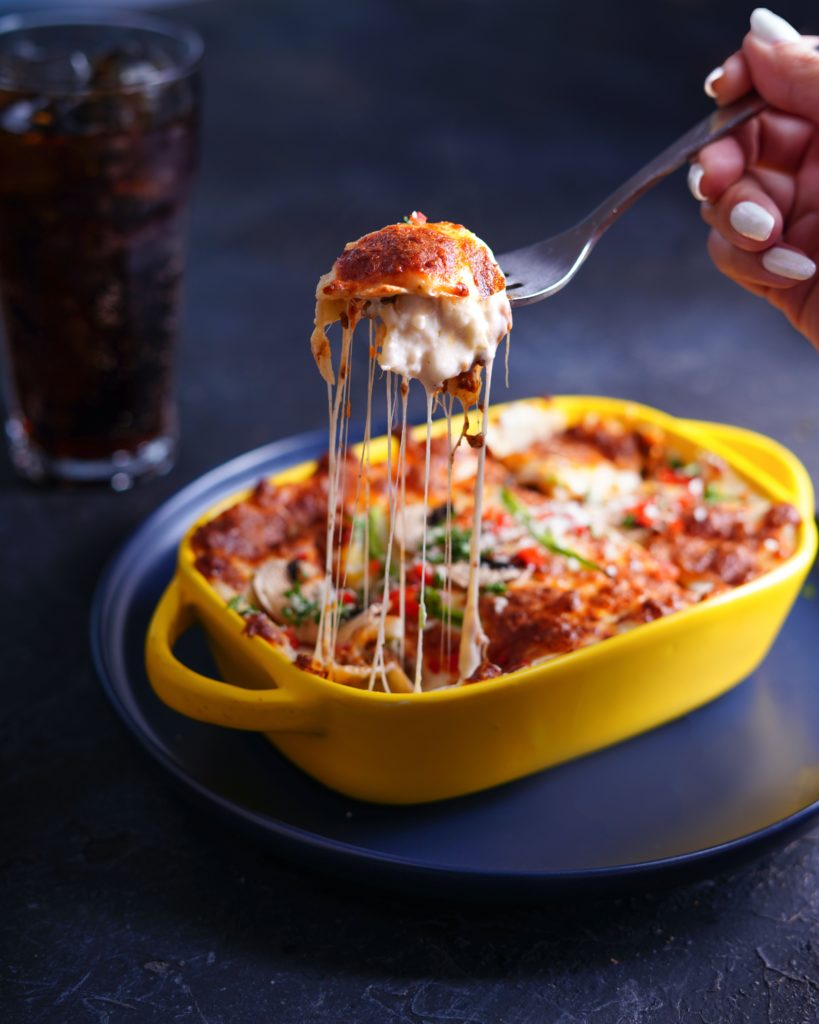
Baked ziti
Baked ziti is a baked pasta dish that’s layered with tomato and cheese sauces, baked until hot and bubbly. It’s the easiest baked pasta you can cook: there’s almost no room for mistakes, and you are assured to enjoy a yummy meal. For extra flavor, you can also add meatballs for baked ziti meatballs or ground beef for baked ziti bolognese.
Lasagna
Lasagna is one of the most well-known baked pastas, filled with layers of savory meat sauce, creamy bechamel and rich shredded cheese. As a vegetarian, I really enjoy to bake it with vegetables, like the classical ricotta and spinach lasagna, or with zucchini, eggplant and tofu.
Mac and cheese
In Italy, there is baked ziti, and in the States, there is Mac and cheese! It really is the American take on baked pasta, and this includes everything Americans love: gooey cheddar cheese, creamy cheese sauce made with whole milk and cream, and for extra crisp, you can always add panko crumbs!
2. Make baked pasta with your favorite sauce!
As we’ve seen above, baked pasta is nothing without a good hearty sauce that brings creaminess to the dish and helps packing it with flavors. You can try to add bechamel, cheddar or arrabiata sauce to your favorite baked pasta recipe to add a little je ne sais quoi to impress your guests.
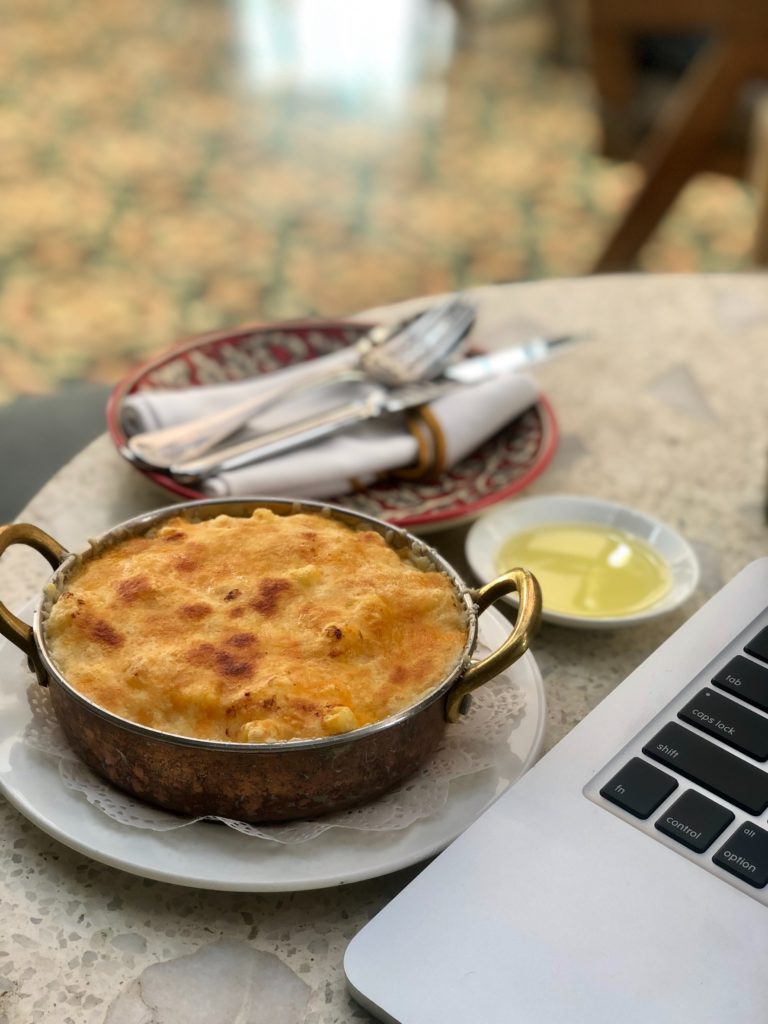
For the meat eaters, try baked pasta with meatballs, baked ziti bolognese or baked penne pasta with ground beef. You could also try tuna pasta bake for a lighter baked pasta dish.
If you are vegetarian, baked pasta offers you great options! Try baked zucchini lasagna, baked tofu lasagna or baked eggplant parmesan. For a lighter baked pasta dish, bake penne pasta with fresh veggies such as mushrooms and broccoli, or mix in some baked quinoa for added protein.
3. It’s just so easy!
It usually takes 20 minutes top to cook a baked pasta dish, and maybe 30 minutes more for it to cook.
And it’s not like you have much to do: just cook your pasta as told on the package and prepare a yummy sauce. Grab a baking dish, assemble, and voilà! Whether you’re in the mood for cheesy baked mac and cheese or baked ziti bolognese, there’s something out there for everyone. So why wait? Start browsing baked pasta recipes and cook!If you too suffer from the post-party pasta craving, don’t forget to save some of your delicious baked pasta in the freezer. This will provide a readymade treat when you need it most!
It’s our favorite time of the year! Christmas is around the corner and we are thinking about what we will cook. This year we want to make our families taste Italian Christmas food. But what are Italians eating for Christmas? Well, it depends if it’s Christmas Eve’s dinner or Christmas Day’s lunch. But don’t worry pasta lovers, pasta dishes will be involved for sure! Let’s take a closer look at this Natale food.
The traditional Italian Christmas eve dinner
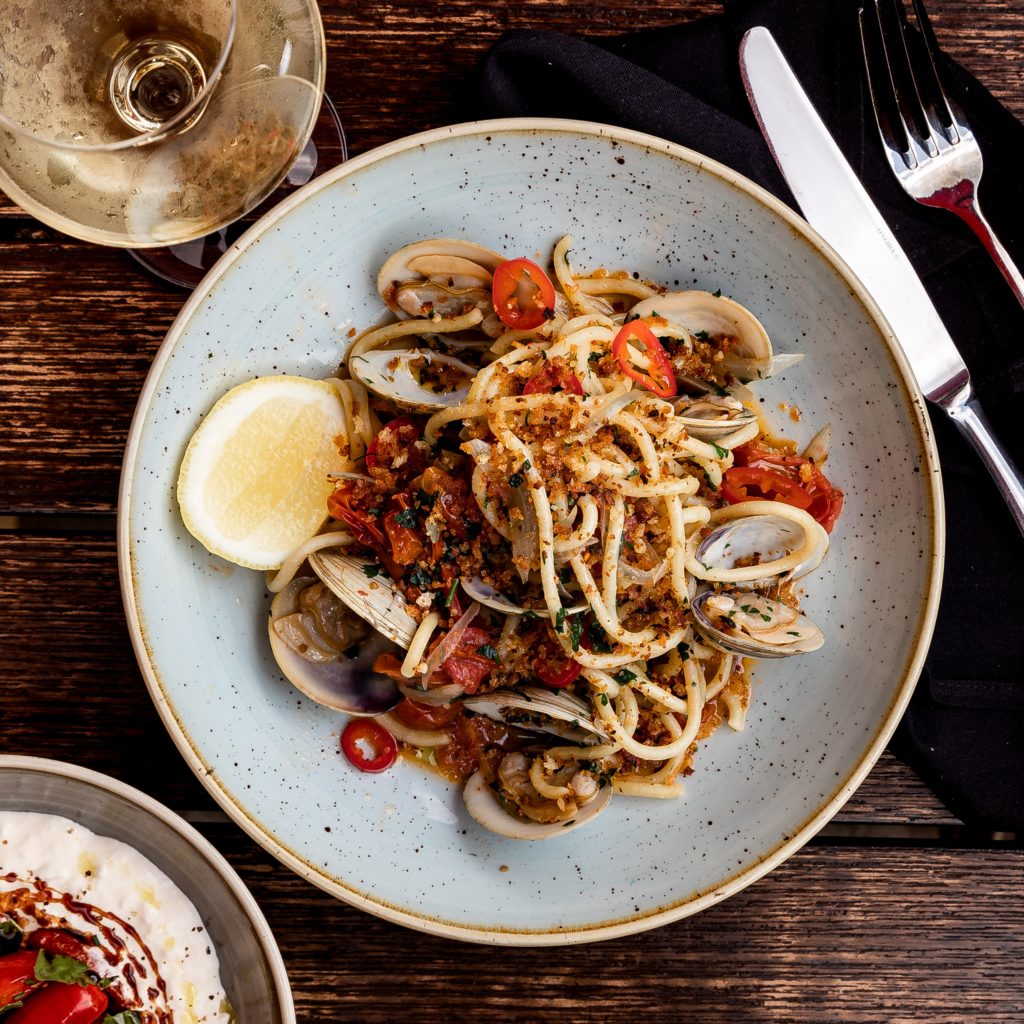
Traditionally, the Italian Christmas Eve food is far lighter than the Italian-American one, as it mainly consists in no meat and a lot of seafood. A bounty of seafood awaits you at the table: succulent swordfish, luscious tuna, octopus and rich salmon. Enjoy delicate calamari or savor linguine topped with a mouthwatering clam sauce. You can taste the famous Italian dish made of salted cod: baccalà. It is the most iconic dish of Venetian cuisine. Centuries ago, Venice was a bustling epicenter of European commerce and it became commonplace to discover salted fish from Norway… That’s how the beloved dish baccalà was created.There’s not only seafood on the Italian Christmas table. In Northern Italy for example, gnocchi and stuffed pasta are a must. You can try gnocchi alla trabaccolara. This traditional Christmas gnocchi was born in Viareggio in the late 19th century. It is originaly a poorman’s dish composed of tasty gnocchi and a fish fumet. And if you are more into stuffed pasta than gnocchi, you can try cappelletti. It is a small stuffed pasta that is part of the Christmas tradition of the Emilia Romagna region in Northern Italy. Cappelletti are usually filled with meat or fish and served in a broth.
A fun twist: the Christmas pizza

While the concept of having pizza for Christmas may seem peculiar, Italians have their own unique and delicious dish – a Sicilian Christmas pizza! This pizza stands out from the rest with its crunchy, bread crumb-covered crust. The key ingredient to our succulent sauce is a mix of onions and anchovies, yet we wouldn’t want you revealing that to your guests – unless you feel adventurous enough! This pizza is a whole new experience with its wet dough and savory sauce. You will love it! For a unique spin on the holiday season, try out this delicious Christmas tree pizza for your kids! To create a festive treat, shape your dough into the form of an evergreen Christmas tree. Get creative and customize your pizza with a one-of-a-kind topping. This is a fun Christmas activity to do with your children! If you are vegetarian, don’t shy away from creating a delicious veggie Christmas pizza with cream and mushrooms. It’s the perfect dish for all your holiday festivities!
What’s for dessert?
Now it is time for the best part: dessert. The most famous Italian Christmas sweet treat is panettone. A beloved Italian Christmas bread created in 1495 during a luxurious Christmas banquet given by the Duke of Milan. It is a fluffy Italian sweet bread filled with candied orange and citron peels. Panettone is so delicious that we are sure you will want to have some all year round! What’s great with this Italian Christmas cake is that many options exist: panettone bread pudding, panettone French toast, and even chocolate panettone!
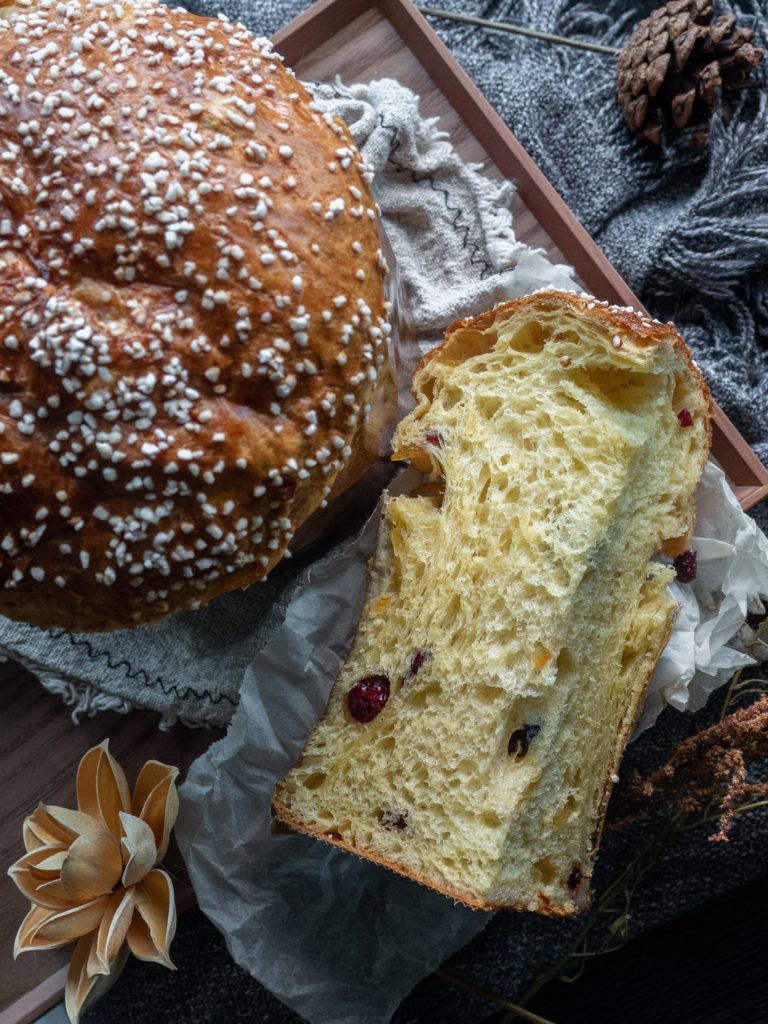
Another Italian dessert that you can enjoy on the holidays is pandoro – golden yellow Italian panettone. It was created in 1894 by chef Domenico Melegatti. This star-shaped cake is made with Italian cake yeast and dry milk, so it is a light and airy cake that you won’t be able to resist!
Biscotti are Italian cookies that are a must-have Italian Christmas dessert. Italian biscotti come in many different flavors, but you can never go wrong with classic Italian almond and pistachio recipes for the holidays. This Italian Christmas cookie comes from Tuscany and became a classic Italian Christmas treat.Now I want to tell you about my favorite: torrone. This Italian nougat is made with toasted nuts and honey – a delicious Italian Christmas candy that you can enjoy for the holidays! The history of this Italian Christmas candy is really interesting because it is believed that it derives from an Ancient Roman treat… But we aren’t sure about that, so some say it comes from an Arabic dessert.
How do you celebrate Natale?
Whether you are more a pasta or a pizza lover, the Italian tradition has a savory dish for you. This year, I want to try to make my own Italian Christmas candies and experiment a torrone recipe. Keep in mind that the most Italian Christmas thing is sharing a good time around the table with your loved ones. Buon Natale from all of us at Pasta Pizza!
Raviolis are one kind of stuffed pasta that we love for its versatility: depending on the filling we choose, it can be packed with tons of different flavors and can suit many pasta lovers. However, we tend to always eat them with the same filling and tomato sauce! But the thing is, you can fill them with any combination of ingredients that you like: veggies, meat, seafood, cheese… For the pasta aficionados out there, we’ve compiled our 10 favorite ravioli fillings! But before preparing the filling, make sure your pasta dough is ready.
The classic spinach-ricotta ravioli filling
We love to combine spinach and ricotta cheese with pasta! This generous filling is perfect if you are in a hurry and need a quick recipe. To make it you will need fresh spinach, ricotta cheese, lemon zest and nutmeg for extra taste. I love to combine spinach-ricotta ravioli with a classic fresh tomato sauce, or a cream and lemon sauce to enhance the ricotta’s fresh taste.
The meat lover ravioli filling
This filling is definitely a classic. You can make your own meat ravioli with ground pork or beef seasoned with salt, pepper, nutmeg and onion. Some people like to add other ingredients such as raisins or pine nuts to the filling for extra richness and texture. Spicy arrabbiata sauce pairs perfectly with meat-filled raviolis.
A taste of winter: gorgonzola, apple and walnut ravioli filling
This is the ravioli for cheese lovers. Gorgonzola is a rich and flavorful Italian blue cheese, perfect for those chilly winter nights. Pair your gorgonzola ravioli with apples or walnuts to add a punch of sweetness and crunchiness to your filling. To top your gorgonzola filled ravioli, just add some good olive oil, salt and pepper on top.
The yummy vegetarian mushrooms, cheese and cream ravioli filling
If you’re a foodie who loves the taste of garlic and butter, then you’ll love these mushrooms filled raviolis. Mushrooms add an earthy flavor and texture to this pasta dish. If you want a gourmet taste, add some Parmesan and mozzarella to the filling. And when it’s ready, top the ravioli with some cream and cheese that pairs well with it. All the vegetarians will love it!
The pumpkin and Parmesan cheese ravioli filling
Looking for a pasta dish that’s perfect for the fall season? Look no further than the pumpkin and Parmesan ravioli filling! This pasta dish is filled with flavorful roasted pumpkin, garlic, butter, and of course, plenty of tangy Parmesan cheese. Top your ravioli with some fresh herbs like thyme or rosemary to add this little “je ne sais quoi” that will make this dish unforgettable.

Easy meat ravioli : mozzarella and ham filling
We know children can be picky when it comes to food. That’s why I wanted to share with you this easy-to-cook yet still delicious mozzarella and ham ravioli filling. To cook this easy meat ravioli filling, just combine mozzarella cheese with some pre-cooked ham and a little bit of cream, and you are good to go! You can add a little twist by adding parsil, basil and Parmesan cheese. A pasta dish that your kids will definitely love.
A taste of Italy with the pesto ravioli filling
Usually pesto is used for pasta sauce. But did you know you can fill pasta with it? There are times when I feel like indulging in classic Italian cuisine, and nothing satisfies me more than a plate of ravioli filled with delicious pesto with some olive oil and salt on top. It’s simply a pasta dish that’s bursting with flavor. With the fresh basil, garlic and walnuts mixed in olive oil, how can you say no to this pasta dish? Whether you prefer your pesto plain or with a little Parmesan cheese on top, it doesn’t matter – both are equally delicious!
The comforting sweet potato ravioli filling
This is an easy recipe for a sweet and comforting dish. The sweet potato ravioli filling is made by boiling the potato in water, then adding sugar, nutmeg and garlic cloves. Once mashed, it’s ready to be enjoyed! Serve it with a drizzle of honey or some pistachio nuts to add that extra sweetness and crunchiness to every bite!
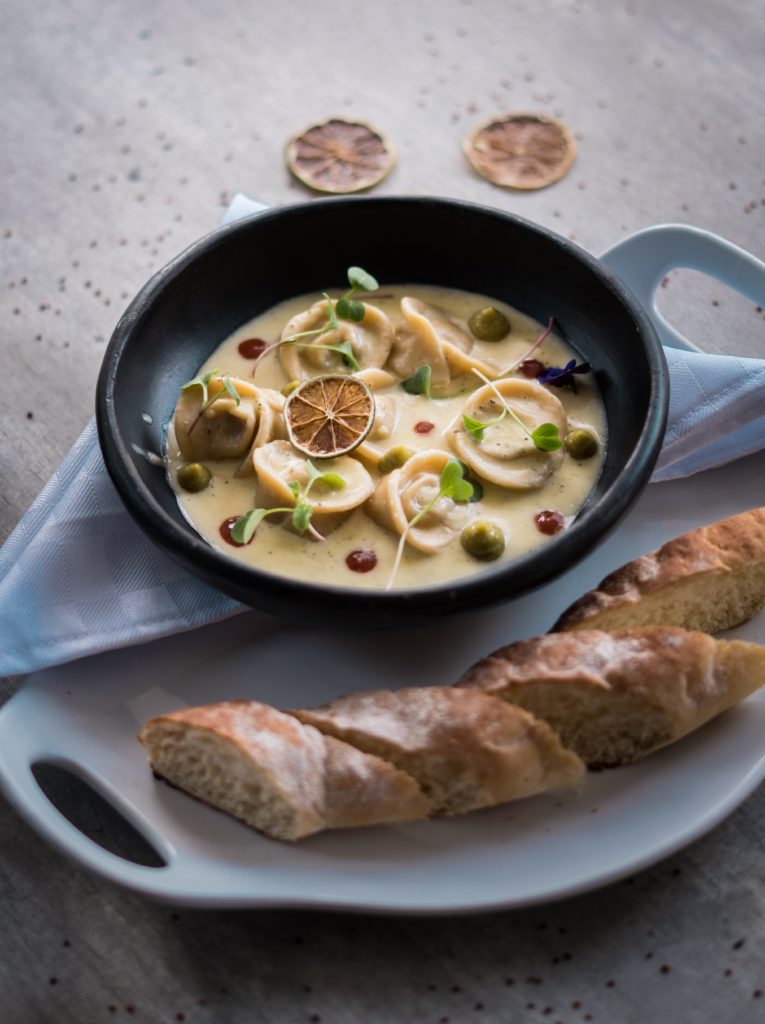
Fancy ravioli: the lobster filling
The combination of pasta and seafood is a great way to enjoy both Italian and seafood flavors in one meal! These lobster ravioli will make you feel like a pasta aficionado and impress your friends. And the best part is that this ravioli recipe is easy to make! You only need cooked lobster, ricotta cheese and lemon zest. For an elevated flavor, be sure to try this dish with sage butter sauce. And if you don’t have lobster, you can replace it with crab. So, what are you waiting for? Make some lobster ravioli today!
The vegan ravioli filling: tofu and spinach
If you’re a vegetarian, vegan, or lactose intolerant looking for a light pasta dish that is also delicious, then look no further than the vegan ravioli filling. This pasta dish is hearty and flavorful, perfect for a weeknight dinner or weekend lunch. Featuring tofu and spinach as the main ingredients, this dairy-free ravioli filling also includes sautéed onions, garlic, and fresh herbs like basil and sage. And to add some acidity, try pairing your ravioli with a squeeze of lemon or a vegan garlic butter sage sauce.
Raviolis for everybody!
Whether you love meat, eat only seafood, are a vegetarian or vegan, there’s always a type of ravioli for you! As a vegan, I personally love the ravioli filled with tofu. And I also experiment with vegan cheese for the filling combined with herbs or veggies. With so many flavors and fillings to choose from, there’s really no excuse not to try them all and be creative. So go ahead – open up your kitchen and start cooking! Who knows? You may just discover your new favorite pasta dish.
Stuffed pasta is a large family of pasta that includes the most well-known ravioli and tortellini, but not only! We’ve already covered the different shapes of stuffed pasta, but did you know you can also stuff shell pasta? Not the ones you find in the sea, no, simply pasta in the shape of shells!
Shells pasta are not actually meant to be stuffed, but that doesn’t mean they cant! They make preparing homemade stuffed pasta much easier, since you don’t have to make the dough.
Be ready to become addicted, those shells can be cooked in so many different ways!
What are stuffed shells?
Stuffed shells are, as their name says, a type of dry pasta in the shape of a shell. They are made with conchiglioni pasta. Their ridges are close together and they can be stuffed with a variety of fillings, the most common ones being a mix of meat, cheese, and veggies.
Unlike typical stuffed-pasta like ravioli or tortellini, shells are not closed when stuffed: they act as “pockets” for all kinds of fillings. This means you will need to cook the pasta before stuffing it and then finish it up in a frying pan or in the oven to ensure that your filling stays in place.
Once done you’ll be able to enjoy the full flavor of the filling of your choosing surrounded by a soft layer of al dente pasta. All in one bite!
Whether you like them plain, topped with cheese, or completely smothered in sauce, there are endless possibilities when it comes to stuffing pasta shells.
Stuffed shells are the easiest way to make homemade pasta
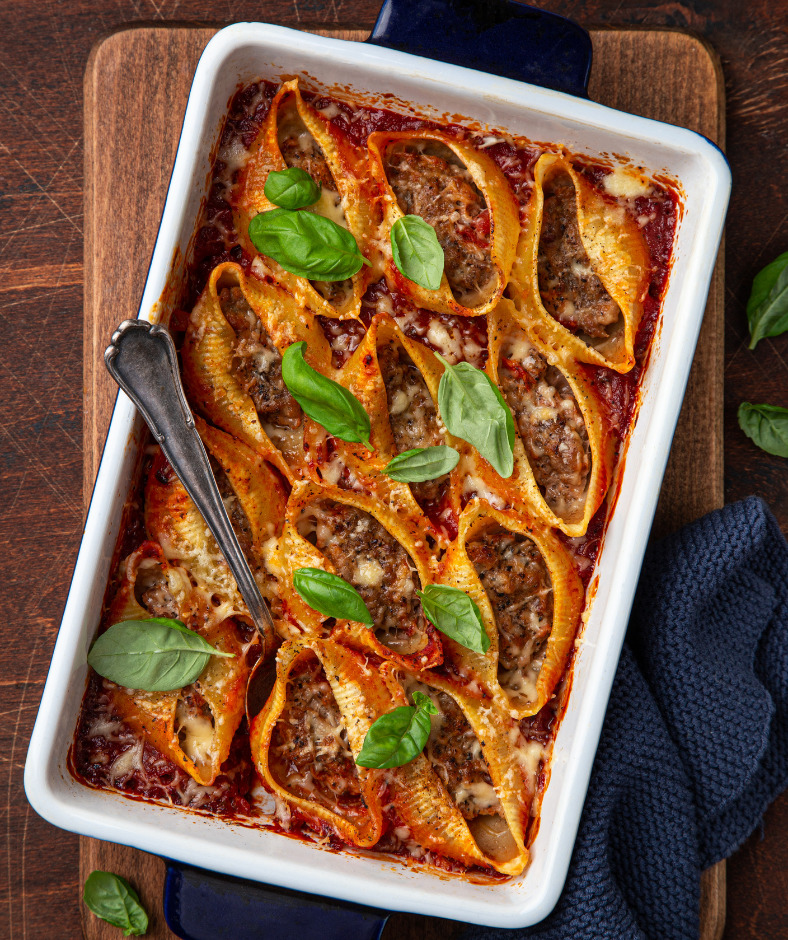
We know that making your own pasta can take time, but mamma mia the taste is so different! We can’t stress enough how great it is to make your pasta from scratch.
Whether you are using a simple traditional recipe or you’re adding your own special ingredients, there is nothing quite like the flavor and texture of fresh pasta.
That being said, we completely understand that many people just don’t have time to make their own pasta. That’s where pasta shells come in, allowing you to focus on the filling while the pasta cooks according to package instructions. That is, approximately 10 minutes.
Pasta shells are great for last minute comfort food whims!
Are stuffed shells for everybody?
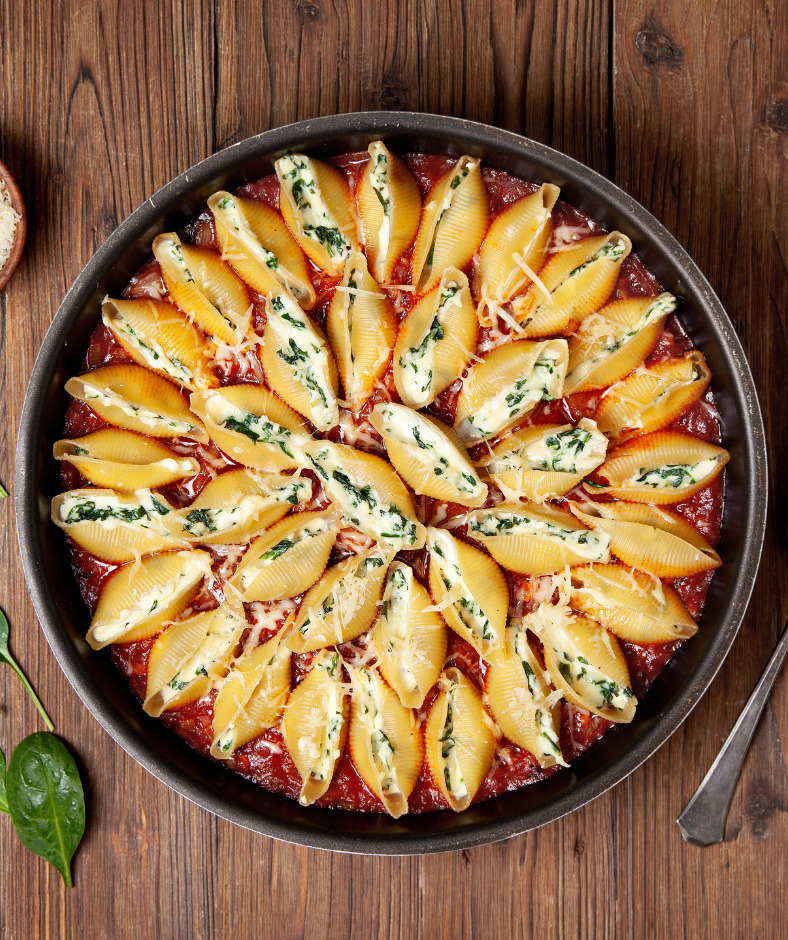
Definitely! It all comes down to the filling.
If you have a hearty appetite, meat stuffed shells are definitely for you! They are perfect for a satisfying pasta dinner, with plenty of sauce and meaty filling to go around.
However, if you are looking for something lighter and more refined, we recommend trying stuffed vegetable shells. And for those of you that are gluten intolerant, some gluten free options can be found in the supermarket!
Whether you are a cheese lover, seafood addict or a vegan foodie, there is always a stuffed shells recipe for you! The key to making great stuffed shells is in the filling.
Our top 3 stuffed shells recipes
We could not let you go without sharing with you our favourite stuffed shells recipes. Our number one is spinach and ricotta shells. It is the perfect recipe if you are in a hurry! You can enjoy the taste of Italy in less than 1-hour meal prep and the vegetarians will love it!
Are you searching for some comfort food? We definitely have what you need with our deep fried mac and cheese stuffed shells recipe. The mix of cheddar, cream, and Parmesan cheese will fill you up after a long winter day spent in the cold.
The Thanksgiving stuffed shells recipe is for the ones who love the holiday vibe and taste. It is a tasty mix of American and Italian cuisine. And it is an alternative to pimp your Thanksgiving leftovers.
For all the pasta lovers…
For all the pasta connoisseurs out there, stuffed shells are definitely a must try! You will have a lot of fun trying out different fillings and sauces. And you can save some of it in the freezeer to satisfy your stuffed shells addiction whenever please.
Cooking pasta might seem super simple, and it is, but there are little things we can do to make sure our pasta tastes even better. Adding salt to the water before boiling the pasta is one of those little things.
In this article we are going to be looking at why you should add salt to the water before boiling pasta, when exactly you should add it, and how much salt is the right amount to add.
Why add salt to the water?
In general, when cooking, salt enhances the flavor of our food. That is why often we try our food, and if we feel it’s too bland we add salt to try to make it more tasty.
This is also true for pasta, and since our pasta will actually be absorbing some water when we boil it, if that water contains salt dissolved into it, our pasta will absolve it to.
You might be thinking that pasta itself (without any sauce) has no flavor, but it does, and allowing it to absorb that salty water (instead of plain water) will help bring that flavor out. This becomes even more apparent when cooking flavored pasta, like beet pasta, pumpkin pasta, calamari pasta, etc. or when pairing your pasta with very light sauces.
There is another reason why adding salt to the water in which we boil our pasta helps our pasta cook better. Salt water boils at a higher temperature. Ok, I’ll admit this is not a huge difference, specially when considering the small amounts of water and salt we use to boil water at home. But if we can make our dish 1% better, why wouldn’t we?
Unless you are trying a slow cook recipe, most foods preserve their taste and nutrients better if they are cooked fast. So if salty boiling water is hotter than fresh boiling water, our pasta will cook slightly faster in the salty option, therefore preserving more of it’s flavor, texture and nutrients.
How much salt to add?
Most Italian chefs recommend adding 10-15 grams per liter of water. That is around 2 tablespoons of salt per liter of water.
This is the part that, even people who are aware of the importance of adding salt to the water before boiling the pasta, get wrong. Most people add just a pinch of salt, as if they were seasoning the dish when it is already on the table. This is not enough to have the effect we are looking for.
See, if you are cooking soup, or a stew, or meat… everything you put into your pan will stay there (except for a small portion maybe, which might evaporate). That means if you add 1 tablespoon of salt to your soup, you will be eating 1 tablespoon of salt when you consume that soup. Makes sense right?
Well this is not the case when boiling pasta. We are adding the salt to the water in which we boil the pasta, most of which will be discarded when we strain the pasta. Most of the salt will go down the drain with the excess water. Only the salt in the small portion of water the pasta absorbed will make it to our dish.
Just to give you an idea of how salty the water in which you boil your pasta should be, think about this. In many Italian towns and cities located next to the sea, it is, or at least it traditionally was common for people to boil pasta directly in sea water!
When to add the salt to the water?
Now, this is another important thing to consider. Should we add the salt to the water as soon as we put our pot on the stove or should we wait?
The answer is we should wait until the water starts boiling before adding the salt.
The reason for this is because salt water takes longer to boil than fresh water. If we were to get into the chemistry of this we would find that there are a lot of variables involved, but as a rule of thumb we can say that salt water takes approximately 1 minute longer per liter to boil than fresh water.
When making pasta at home, your pot will usually contain 2-3 liters. If you add the salt before the water boils you will have to wait an additional 2-3 minutes before you can through your pasta in. No big deal. But if you are cooking for a family of four or five, you pot might contain 5-7 liters of water. Adding an extra 5-7 minutes to the preparation process, specially when talking about pasta, already starts to matter.
This really becomes important when cooking very big batches of pasta. Imagine making pasta at a school or a shelter, were you have to boil 100-120 liters of water. If you add the salt to it right away that pot will take over an hour longer to boil. That’s a lot of time!
On the other hand, if the water is already boiling when you add the salt, it will most likely continue boiling right away or will only take a minute to regain the temperature.
Conclusion
Pasta is a simple dish we can put together quickly, but that doesn’t mean we should pay attention to the details and make it taste as good as possible. Adding salt to the water in which you boil your pasta will help you achieve just that!
Wait until your water breaks to boil and be generous with the amount of salt you add to the water. You’ll notice the difference!
Ravioli is one of those stuffed pasta that is delicious paired with a sauce. The sauce is a way to enhance the filling of the ravioli, and to pack your dish with even more flavours. If you’re looking for something different than the typical tomato sauce for your ravioli, look no further! Here are five super easy different raviolis sauces to try out.
Cheese please: the Alfredo sauce
A classic Italian sauce, Alfredo is the perfect partner for your cheese ravioli. Made with a base of butter and Parmesan cheese, this sauce is creamy and indulgent. It goes great with meat filled ravioli or cheese ones. We love it for a cold winter day, as a comfy and easy-to-do dinner!
To make your Alfredo sauce, it’s simple: in a hot pan, melt butter, Parmesan cheese and cream. Stir until the sauce is smooth and creamy. You just have to season it to taste with salt and pepper, and we love to add a little bit of nutmeg. Add your ravioli to the sauce and serve!
For an extra cheesy twist, top your ravioli with a sprinkling of grated Parmesan cheese.
The mushroom and cream ravioli sauce
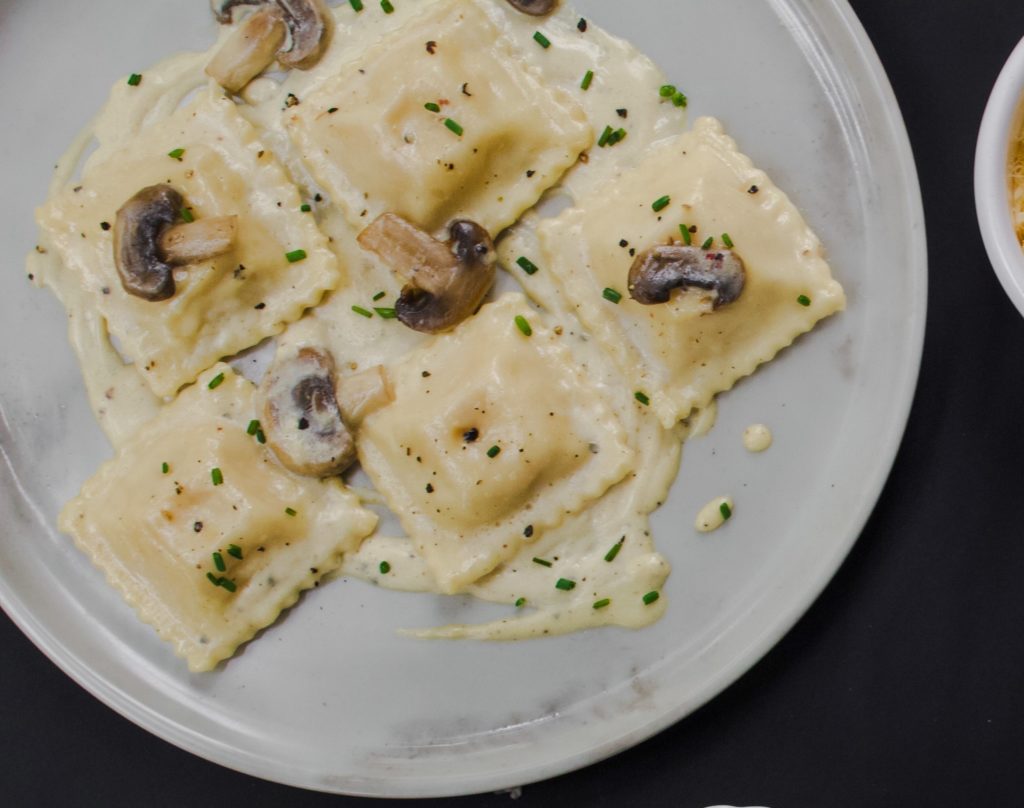
Another classical ravioli sauce is the mushroom and cream one. This rich and creamy sauce is the perfect pairing for meat or vegetables ravioli. Both earthy and decadent, this perfect fall pasta recipe is made with a base of onions, mushrooms, cream, and garlic. I personally like to add a glass of white wine while cooking the onions and mushrooms, to deglaze the pan and bring a little “je ne sais quoi” to this comfy ravioli sauce. Don’t forget to season it with salt and pepper to enhance the flavours. For an extra elegant touch, we like top the ravioli with a sprinkle of chopped chives!
You’d like to make this sauce vegan-friendly? Nothing more easy: use vegetable stock instead of cream!
Spicy Arrabbiata Sauce
For those who like it hot, spicy arrabbiata sauce is the perfect partner for your ravioli. Italians usually cook this sauce with spaghetti, but we love it just as much with ravioli. This tomato-based sauce is flavoured with garlic, chili peppers and garlic, so it is sure to pack a punch!
It goes really well with cheese or vegetables ravioli, but feel free to experiment with different fillings. We love it for a mid-week dinner as it is super easy to make and really satisfying.
If you really want to turn up the heat, add a pinch of red pepper flakes to your sauce.
The classical pesto genovese
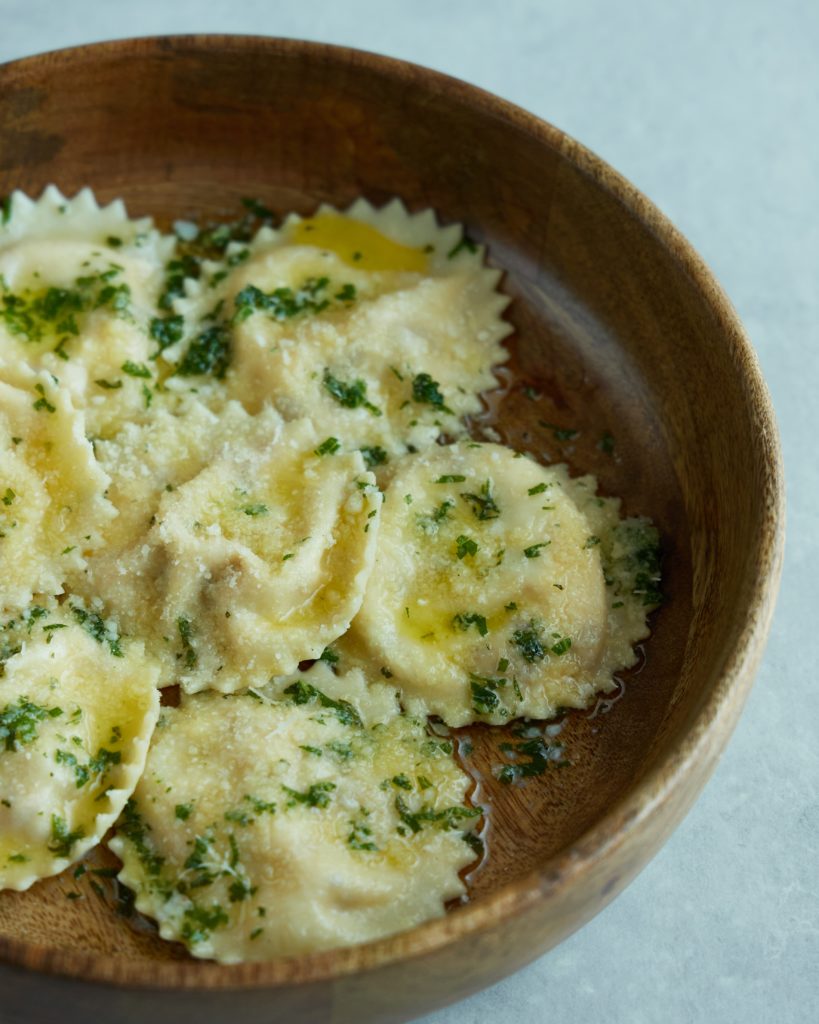
I used to think I hated pesto until I made one at home. And it changed everything! Industrial pesto sauces are usually all blended and packed with garlic and oil, that help preserve the sauce. Basil is also quickly boiled to keep a very green color: but this has the downside to reduce its taste.
At home, you don’t care if the pesto is super green: you just want it to be good! You can also choose not to blend entirely the garlic, pine nuts and basil leaves, so that you have extra texture in your pesto sauce.
Intrigued? Check out our pesto genovese recipe!
Pesto rosso, the delicious cousin of pesto
This vibrant and flavorful sauce is a twist on the classic pesto Genovese. Basil is replaced with sundried tomatoes and chili peppers are added for a bit of spice. There is no cooking involved, and all you have to do is blend!
To make your pisto rosso, simply blend sundried tomatoes, garlic, olive oil, chili peppers, and Parmesan cheese in a food processor. Season it with salt and pepper to taste. This ravioli sauce is perfect with ricotta and spinach filled ravioli, but feel free to experiment with different fillings!
With or without sauce, that is the question!
We hope you enjoyed our top 5 of different ravioli sauces. Those sauces are perfect for every kind of fillings and also every kind of pasta lover, whether you like them with meat or not.
Obviously, ravioli are also delicious on their own, with just a little bit of olive oil and salt! But we have to say we love them even more with a flavorful sauce. What’s your favorite ravioli sauce? Let us know in the comments below!
Everyone loves pasta. It’s easy to cook, quick, and it can be paired with a ton of different sauces, making it simple to find a good combination for every occasion.
The thing is, I don’t know about you, but I’m terrible at measuring pasta servings, and I often (actually, always) cook too much. Cooked pasta can be kept in the fridge for a few days, it can even be frozen, but it usually isn’t as good the second time around.
Let’s face it, freshly cooked meals taste different, but your reheated pasta could probably taste a lot better if you knew how to reheat it properly. I know I didn’t until recently, and it makes a world of a difference!
How NOT to reheat pasta
Let’s start by looking at some possible methods you might be currently using to reheat your pasta and see why they aren’t all that great.
Microwaves
What can I say… microwaves messes up food in so many ways. I dries it up, makes it mushy… and sure, there are tricks to make it better, like putting a glass of water next to your dish while reheating it, covering with a perforated lid, etc.
But all this is just trying to fix something that’s broken from the beginning… Unless you are hearing up water, sauce, melting butter or something along those lines, stay away from the microwaves!
Frying pan
The frying pan is a step up from the microwaves. What you usually do is preheat your sauce in the pan, then add the precooked pasta and steer.
The problem with this method is that you must keep the pasta in the pan for at least 4-5 minutes if you want it to really warm up. Even longer if you are putting it in straight out of the fridge. Considering fresh pasta cooks in just a couple of minutes, and dry pasta usually does in 8 to 10 minutes, keeping it in the frying pan for an extra 5 minutes is a lot. Your pasta will either end up overcooked, burned, or not uniformly warm.
The BEST way to reheat pasta
If you want your precooked pasta to feel and taste as closely as possible to when it was freshly boiled, here is what you should do.
- Preheat your sauce of choice in a frying pan and set it apart in a bowl.
- Boil some water, as if you were going to boil new pasta.
- Once the water is boiling, through in your precooked pasta for 20 seconds, 30 seconds max.
- Strain the pasta and put it into the bowl with your warm sauce. Mix well, and serve!
That’s it, I guaranty your pasta will feel 10 times closer to freshly prepared pasta that it would if you put it in the microwaves or frying pan.
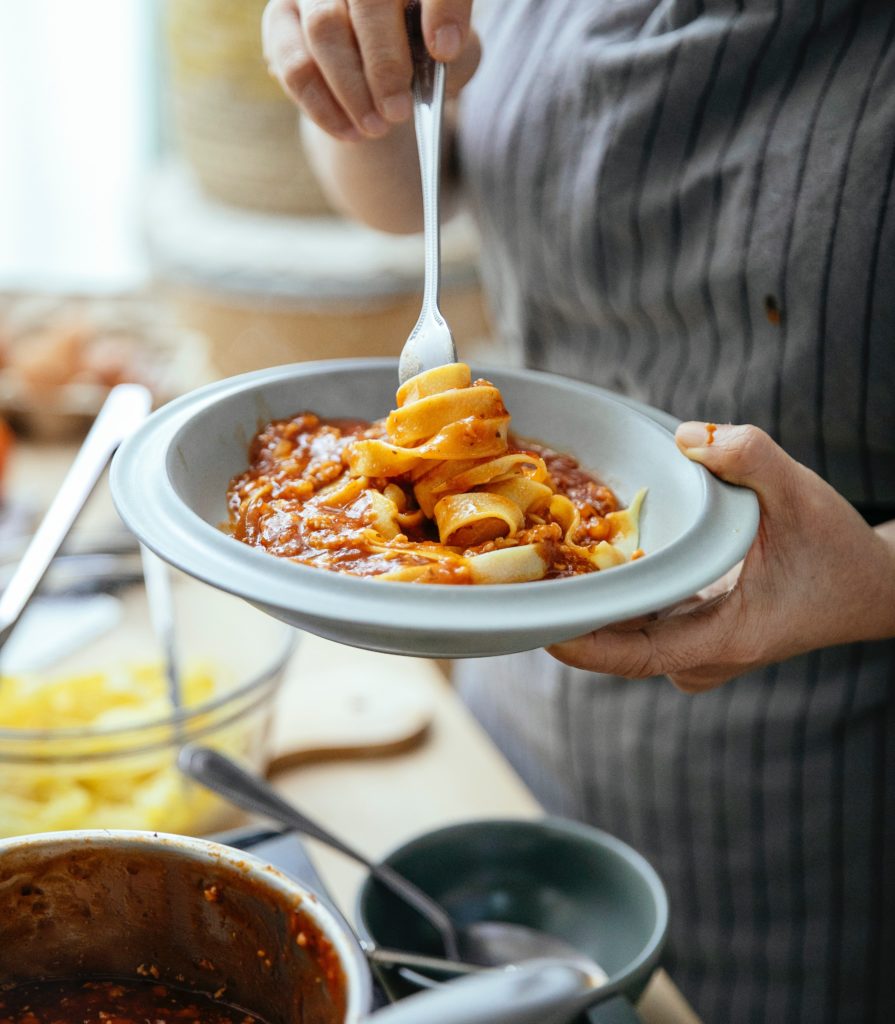
Why does this method work better?
Boling water reheats your pasta quicker, more evenly and loosens it up so that it’s not sticky. This means your pasta wont be overcooked (or only 20 seconds over cooked, instead of 5 minutes), the temperature of your food will be uniform and your pasta will be loose and mix much better with the sauce.
Microwaves heat from the outside in, and so does the frying pan. When you through that block of pasta from the Tupperware to the pan only some of the pasta touched the hot surface. Only after a few minutes that block will start to undo, but the pasta that was in the center of it will still be cold. Water touches almost all the surface of your pasta at once, it separates the noodles (or penne, fusilli or pasta shape of choice) from each other and therefore manages to raise it’s temperature much quicker, without overcooking it.
Conclusion
Give this method a try next time you make to much pasta and want to reheat it. Sure, it might take you 3 or 4 minutes longer to reheat your dish this way than it would in a pan, or even 10 minutes longer than it would in the microwaves, worst case scenario. But the result really isn’t comparable!
Pasta, noodles, what’s the difference between the two? If you are a food lover like we are here, you might wonder what’s the difference between pasta and noodles. They both are delicious, you can eat them with different sauces, stir-fried or even broth, so they must be the same, right? Well, not really.
Pasta and noodles differ in their shapes, origins, and ingredients. For instance, pasta is made from durum wheat and usually has a tubular shape. On the other hand, noodles are made from egg and soft wheat and come in a variety of shapes like spirals or flat strips. But their difference doesn’t stop here. Come on, let’s dig what makes those two apart!
What is the difference between Italian pasta and Chinese noodles?
The legend says that noodles were introduced to Italy by Marco Polo during the 13th century. However, history may say a different thing: although the exact origins of pasta are unknown, it is believed to date back as early as the 4th century BCE. This is based on an Etruscan tomb which depicts a group of people making what appears to be pasta. On the other side, noodles were being consumed in China as early as 3000 BCE.
Chinese noodles and Italian pasta mainly differ in the way they are made. For starters, noodles are typically made from egg and soft wheat, while pasta is made from durum wheat, eggs, salt and sometimes olive oil. If you consider gnocchis to be a kind of pasta, you can even say they are made from potatoes, and some pasta are even made from ingredients not typical! This means that noodles are more delicate and have a higher protein content than pasta.
Noodles are usually long spirals or flat strips, while pasta comes in many different shapes and sizes, such as spaghetti, fusilli, tortellini, bow tie… The list is long and hard to keep up with! Pasta is even stuffed with fillings, and this is what we call stuffed pasta (and there are more kinds of stuffed pasta than just the classical ravioli).
One thing that noodles and pasta share: they can be both found dry or fresh.
When it comes to cooking, noodles are typically boiled, while pasta is usually baked or boiled.
Types of pasta

One thing that may help you to understand the difference between noodles and pasta is listing what different types of pasta and noodles there is. Because once you’ll see the list, you’ll understand pretty quickly!
- Spaghetti : a long, thin, cylindrical pasta made of semolina and water.
- Linguine: a long, flat pasta made of semolina and water.
- Bucatini: a thick, spaghetti-like pasta with a hole running through the center.
- Fusilli : a short, twisted pasta made of durum wheat and water.
- Rigatoni : a medium-sized tubular pasta made of durum wheat and water.
- Penne : a medium-sized, quill-shaped pasta made of durum wheat and water.
- Fettuccine : a long, flat pasta made of egg and soft wheat.
- Farfalle : a bow-tie shaped pasta made of egg and soft wheat.
- Ravioli: a type of dumpling made with a thin dough wrapped around a filling of meat or vegetables.
- Orechiette: a type of pasta made in the shape of small ears, typically made with semolina flour and water.
- Gnocchi: a type of dumpling made with potatoes, semolina flour, and water
- Lasagna : a wide, flat pasta made of durum wheat and water.
And the list could go on again as there so many kinds of regional pasta in Italy!
Types of noodles
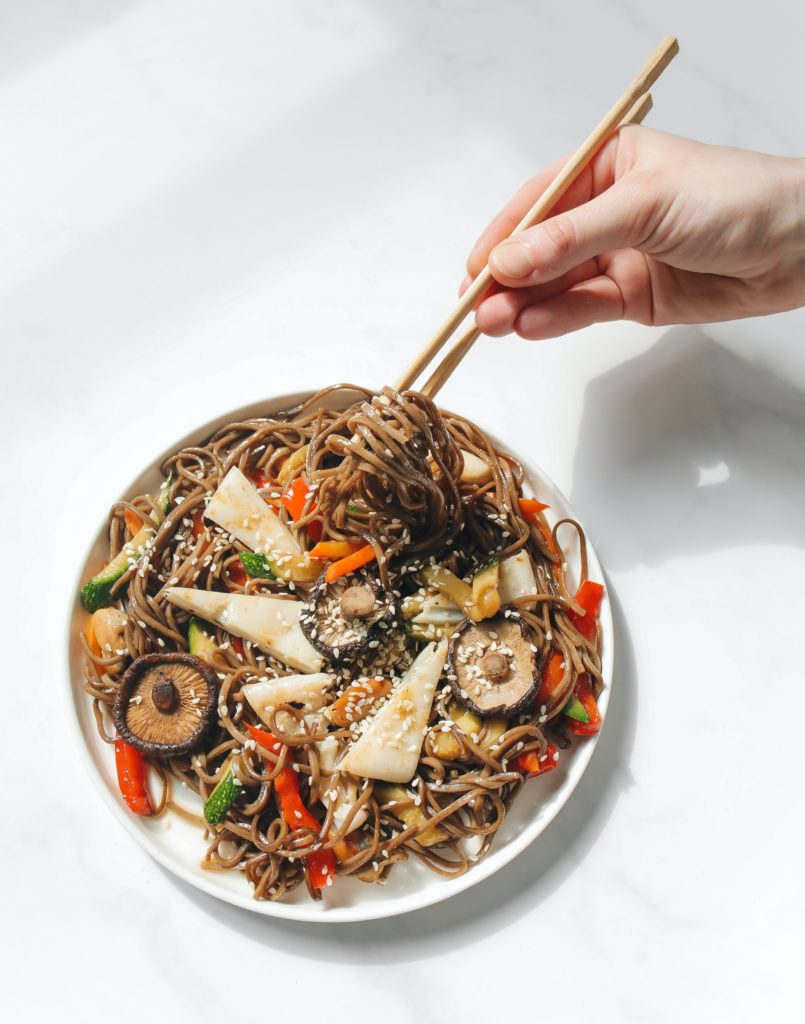
Just as pasta, noodles are also divided into different types. And these, again, come with their own shapes and sizes!
- Ramen noodles : a type of Japanese noodle made of wheat flour, water, and salt.
- Udon noodles : a type of thick Japanese noodle made of wheat flour, water, and salt.
- Soba noodles : a type of thin Japanese noodle made of buckwheat flour, water, and salt
- Lo mein noodles : a thick type of Chinese noodle made of wheat flour and water.
- Pad Thai noodles : a type of thin rice noodle used in Thai cuisine and especially in the Pad Thai recipe
As you can see, there are many types of both noodles and pasta. And we didn’t even list all of them!
Do Italians call it noodles or pasta?
The answer to this question is a little complicated. In Italy, the word “pasta” refers to the dough that is used to make noodles. So technically, all noodles are pasta, but not all pasta is noodles. Confused yet?
Actually, the confusion between the two or even the expression “noodle pasta” is very American. Italian only use the word “pasta” to refer to this dish, while the naming “noodles” is very rooted in the Asian cooking culture. For instance, you’ll never see a “spaghetti noodles” dish on an Italian menu, or a “ramen pasta broth” at a Chinese restaurant!
Which is healthier?
If you’re looking for the healthier option, noodles are the way to go. This is because they are typically made from egg and soft wheat, which makes them lower in calories and fat than pasta. Additionally, noodles have a higher protein content than pasta, which means they will fill you up faster and keep you fuller for longer.
This also has to do with the way they are cooked. Noodles are usually cooked with vegetables or in broth, while pasta is often cooked with heavy sauces. Pasta is also very appreciated with cheese, while you won’t ever put it over a noodles plate!
Fall is here and we are craving some comfort food! With the days getting shorter and colder, we seek for warmth and flavors in our plates. And what’s a better comforting dish than pasta? (Personally, there’s nothing better for me!) From the classical butternut squash pasta to the hearty cheesy pasta gratin, discover our 8 favorite fall pasta recipes for this new season!
#1 – Butternut Squash Pasta
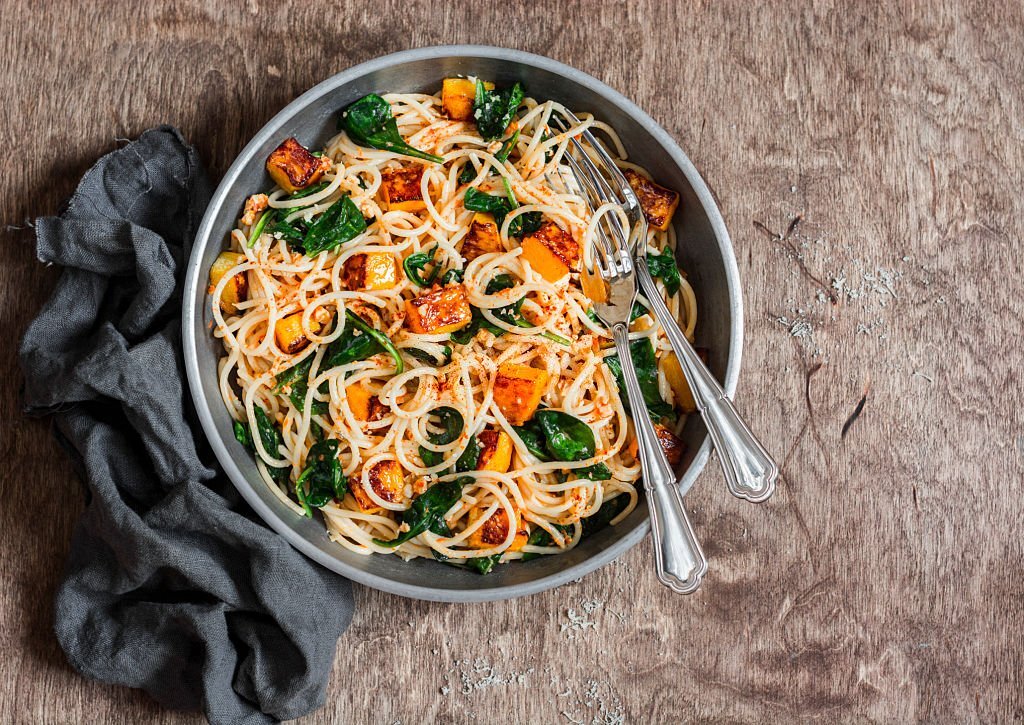
No way we could talk about fall recipes without mentioning butternut squash. This savory and sweet squash has many uses in the kitchen during autumn: it’s delicious in soups or roasted, but did you know you can also enjoy it with your favorite pasta?
The tricky part with butternut is always cutting it, as it has quite a hard skin. Choose your sharpest knife and cut the squash in two to help you peel it. You can also put it whole in the oven for 1 hour, and remove the squash easily when it’s mushy. (Be cautious to do it when the squash has cooled down not to burn yourself!).
To prepare a butternut squash pasta, you’ll want to roast your squash with herbs, usually thyme, and garlic. Then, puree it with ricotta or another cheese to obtain a creamy texture.
Boil your pasta as usual (we love it with spaghetti!) and when it’s done, mix it with the butternut squash puree. For an extra topping, add crispy pancetta or bacon, a tablespoon of ricotta and parmesan and voilà! Here you have the perfect coziest and creamy fall pasta dish ready to eat!
#2 – Smoked salmon and leek tagliatelle
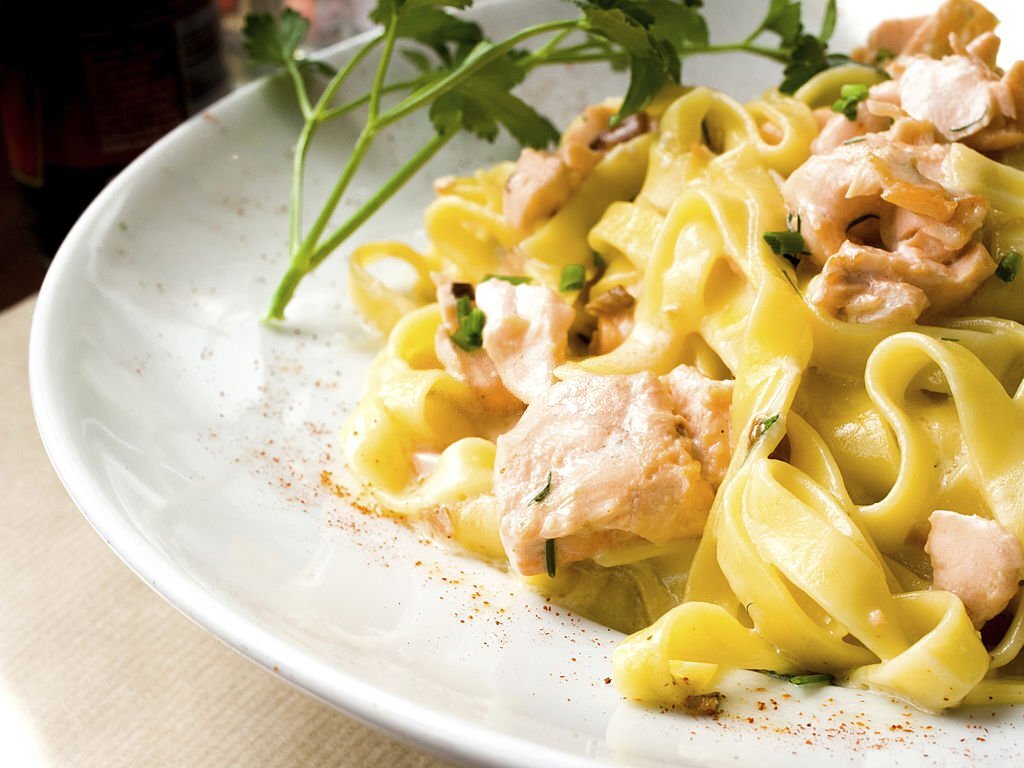
Leeks are another fall vegetable we love to associate with pasta. And leek tagliatelle with smoked salmon is my personal favorite: it reminds me of the meal my mom would prepare for us at night, to comfort us after a long day at school.
I love it, because the leeks melt in your mouth, and the fresh tagliatelle contrast super well with the smokiness of the salmon. It truly is a comforting and generous pasta meal!
And frankly: it’s quite easy to do! You’ll just need 4 ingredients: fresh tagliatelle, leeks (usually two), smoked salmon and whipping cream.
Peel and wash the leeks, then cut them into slices. Cook until they are melting. When the tagliatelle are boiled, mix them with the leeks, the liquid whipping cream and smoked salmon! My personal tip? Add pepper when serving to enhance the flavors of the pasta!
#3- Cheesy pasta gratin
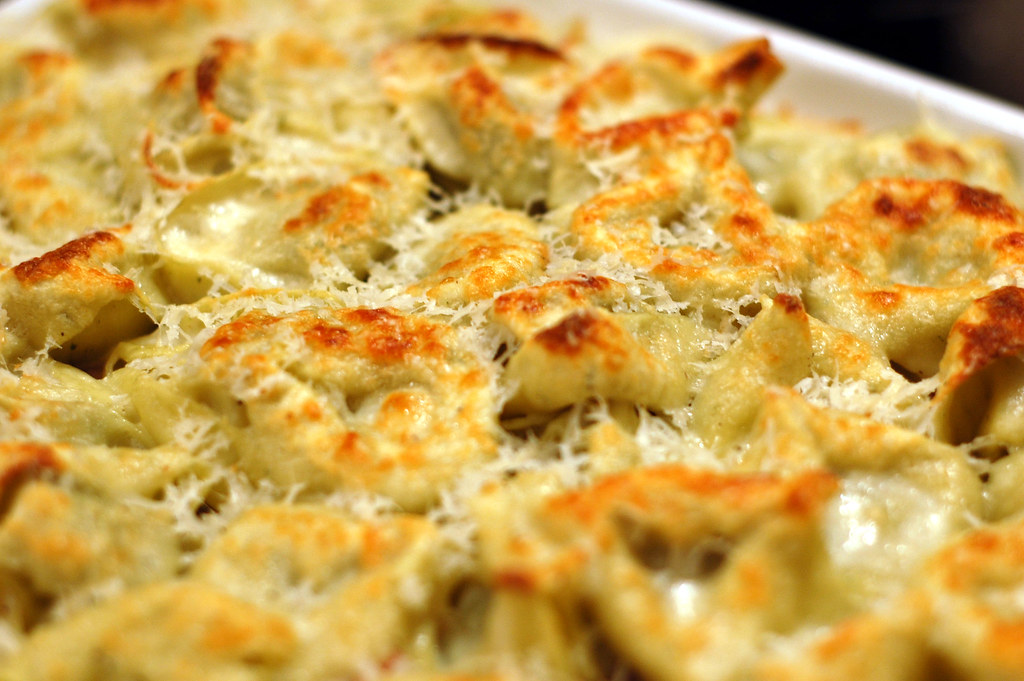
If you’re looking for a hearty pasta dish to keep you warm this fall, look no further than a cheesy pasta gratin. This dish is packed with flavorful cheeses and fresh herbs, making it the perfect comfort food for cooler weather. Serve it alongside a simple green salad for a complete meal.
For a more gourmet take on this dish, try adding some sautéed mushrooms or roasted red peppers. You can also switch up the cheese blend to include interesting varieties like Gruyere or Gorgonzola. No matter how you make it, a cheesy pasta gratin is sure to please!
#4- Creamy mushroom raviolis
Creamy mushroom raviolis are another great option for a fall pasta dish. Mushrooms are in season during autumn, so they make a perfect addition to this rich and creamy pasta dish. You can use any type of mushroom you like: button mushrooms, cremini mushrooms, or even wild mushrooms. If you’re feeling extra decadent, top this dish with some shaved truffle !
This rich and flavorful dish can be made with any type of ravioli, but we love the earthy flavor of mushrooms paired with a creamy sauce. Serve it with a side of garlic bread for a complete meal.
#5- Beef and noodles broth
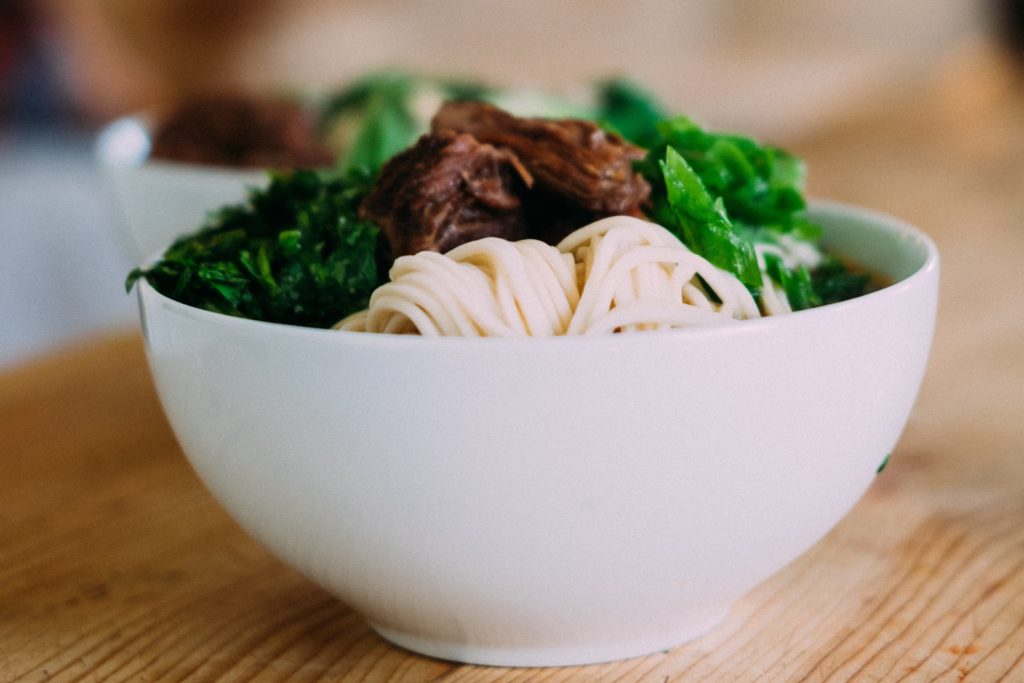
Beef and noodles broth is the perfect comfort food for a chilly autumn day. This dish is made with tender beef, hearty noodles, and a flavorful broth. It’s the perfect way to warm up on a cold day.
To make this dish even more filling, add some chopped vegetables like carrots, celery, and onions. You can also add some starches like potatoes or corn. This dish is best served with a crusty piece of bread for dipping.
#6- Sweat potatoes gnocchi with sage
Ok, let’s be honest: have you tried homemade sweet potatoes ? Really? You’ll know it’s impossible to come back to industrial gnocchi or even regular gnocchi after that! Sweet potatoes gnocchi truly are a fall pasta recipe. We love to pair them with sage because the sweetness of the potatoes is well balanced by the savory sage.
Making sweet potatoes gnocchi with sage is a bit more time-consuming than other pasta recipes, but it’s well worth the effort. You’ll need indeed to peel, boil the sweet potatoes and puree them with flour until you obtain the perfect dough to roll the gnocchi. This takes a bit of times, but let’s say it’s the perfect Sunday afternoon activity on a rainy fall day!
These little dumplings are light and fluffy, and they taste absolutely amazing. Serve them with a simple sauce like brown butter or olive oil and you’ll have a dish that’s fit for a special occasion.
#7– Spaghetti with beet pasta sauce
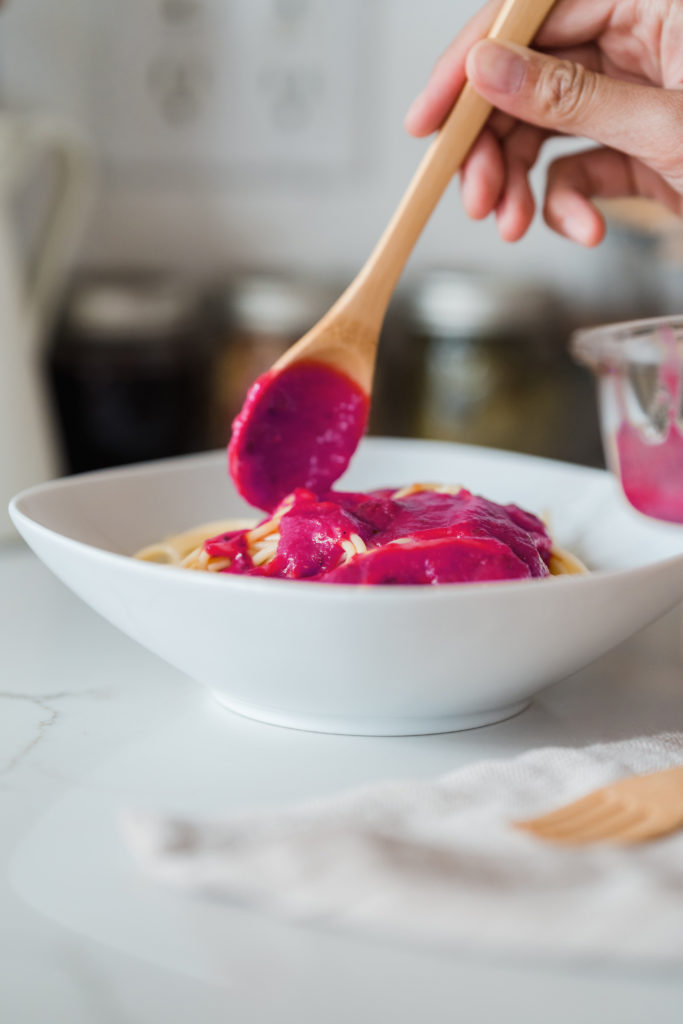
Beets are another fall vegetable that make a great addition to pasta dishes. They also color your pasta pink, which is obviously funny and memorable ! Let’s say it adds some colors to you meals when days can turn pretty grey!
We have actually already shared with you our beet pasta sauce recipe, so check it out! And if you feel like it, you can also make your own beet pasta dough!
#8- Creamy bow tie carbonara with broccoli
What if you added a fall twist to your regular carbonara? Broccoli are in season right now and they would complement the dish so well! Carbonara with roasted broccoli is a great way to change up your usual pasta routine. We love it with bow tie pasta because the little nooks and crannies are perfect for holding onto the sauce.
The key to a great carbonara is all in the sauce. We like ours with a mixture of eggs, Parmesan cheese, and cream. The addition of roasted broccoli gives this dish a beautiful fall flavor that we can’t get enough of. Please, try it and tell us what you think!
If you’ve ever eaten pasta that was overcooked and mushy, you know how important it is to get the perfect al dente texture. Al dente pasta is cooked until it is just firm to the bite, and it’s this perfect balance of firmness and chewiness that makes it so delicious. While al dente pasta may seem like a simple concept, it can be tricky to achieve at home. Here are some tips for perfectly cooked al dente pasta every time.
Any good chef will tell you that one of the most important things to get right when cooking pasta is the “al dente” point. But what exactly does “al dente” mean?
“al dente” literally means “to the tooth.” When applied to pasta, it means that the pasta should be cooked just until it is tender, but still has a bit of a bite to it.
If you’ve ever eaten pasta that was overcooked and mushy, you know how important it is to get the perfect al dente texture. Al dente pasta is cooked until it is just firm to the bite, and it’s this perfect balance of firmness and chewiness that makes it so delicious. While al dente pasta may seem like a simple concept, it can be tricky to achieve at home. Here are some tips for perfectly cooked al dente pasta every time.
There are a few different ways to tell if your pasta is al dente. One is to simply taste it and see if it’s to your liking. Another is to use a fork to test the firmness of the pasta. The pasta is ready when the fork can pierce through the center of the pasta easily, but there is still some resistance.
So what is the difference between al dente and overcooked pasta? And how can you make al dente pasta a home? Keep reading!
The difference between “al dente” and overcooked pasta
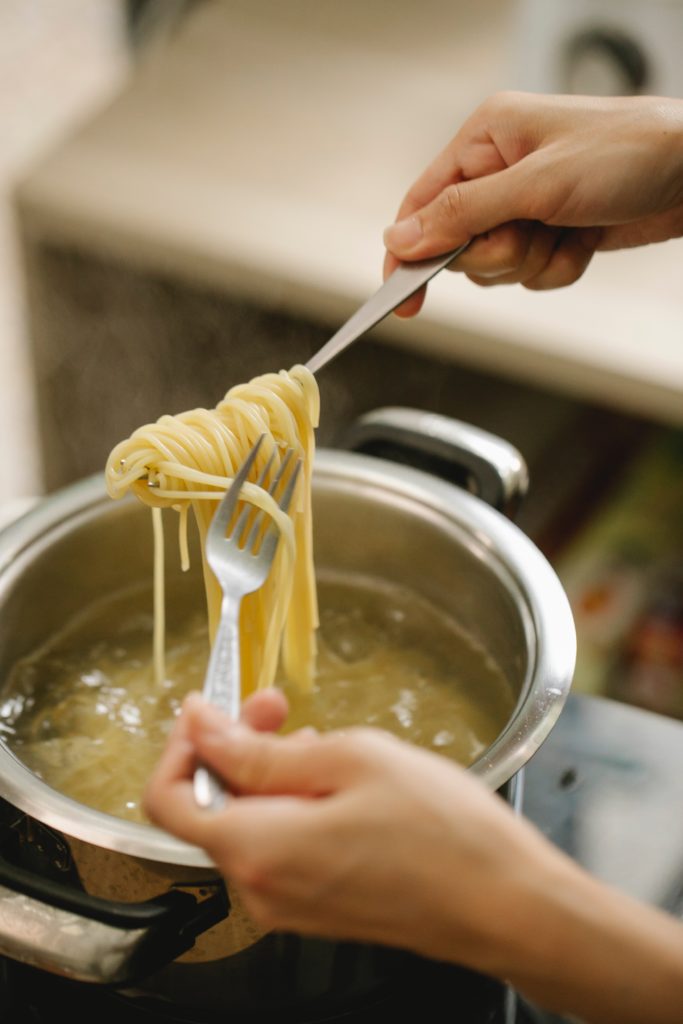
One of the most important things to know when cooking pasta is the difference between al dente and overcooked pasta. Al dente pasta is cooked until it is just firm to the bite, while overcooked pasta is cooked until it is soft and mushy. The key to perfectly cooked pasta is to find the balance between these two extremes.
Why is this the perfect cooking point?
Al dente pasta is the perfect balance of firmness and chewiness, and it’s this perfect texture that makes it so delicious! Al dente pasta is also more nutrient-rich than overcooked pasta because it retains more of its starch. Starch is a complex carbohydrate that provides energy and essential nutrients like iron and vitamin B6.
So not only is al dente pasta more delicious, but it’s also better for you! That’s a win-win in my book.
How long do you cook pasta for “al dente”?
The cook time for al dente pasta will vary depending on the type and shape of pasta you’re using. For most types of pasta, the cook time should be around 8-10 minutes. To test for doneness, simply taste a piece of pasta. It should be cooked through but still have a slight bite to it.
If you’re not sure how long to cook your pasta for al dente, it’s always better to err on the side of undercooking. Pasta can always be cooked for a few more minutes if it’s not quite done, but overcooked pasta is mushy and difficult to salvage.
Tips for making “al dente” pasta at home
If you’re looking to achieve the perfect al dente pasta at home, there are a few things you’ll need to do.
First, make sure you use a good quality pasta. You want to use a pasta that is made with 100% durum wheat semolina. This type of pasta will have the best texture and flavor. You can buy them at most grocery stores.
Second, make sure you’re using enough water. The pasta should be covered by at least an inch of water so it has the room to move around and cook evenly.
Third, stick to the “al dente” time recommendation on the packaging of your pasta. This is usually between 8-10 minutes, but this can vary depending the type of pasta you’re cooking: long pasta like spaghetti, stuffed pasta, and obviously dry or fresh pasta.
Finally, stir the pasta frequently during cooking to prevent it from sticking together and becoming overcooked. And of course, don’t forget to taste the pasta as it’s cooking to gauge its doneness.
With these tips in mind, you should be well on your way to perfectly cooked al dente pasta every time. Happy cooking!

